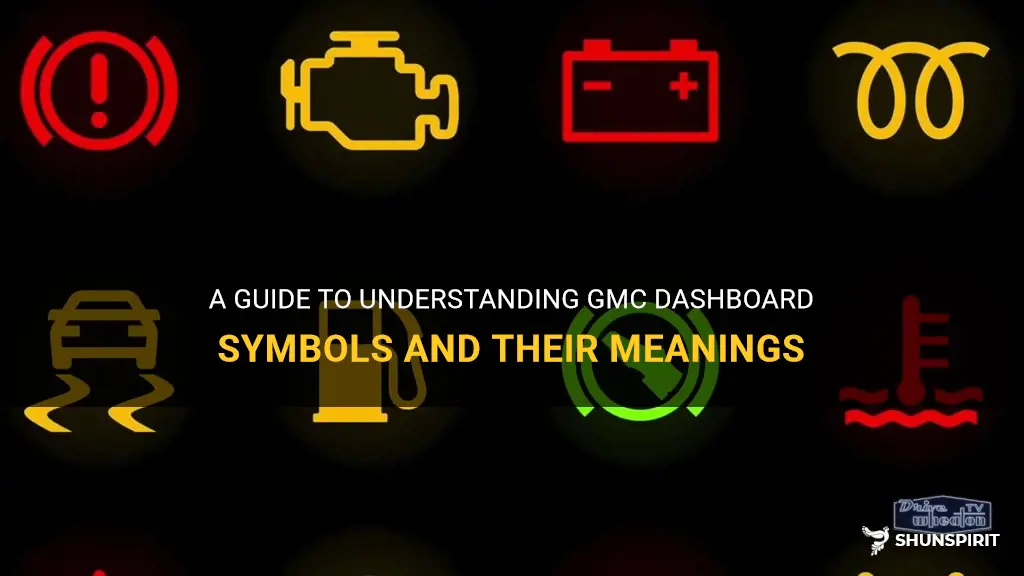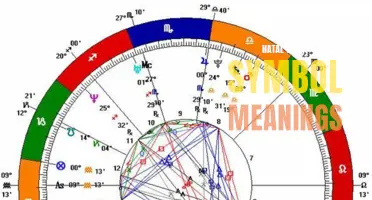
Have you ever glanced at your GMC dashboard and found yourself puzzled by the array of symbols and indicators staring back at you? Fear not, for we are here to decode these enigmatic signs and uncover their meanings. Whether it's a warning light indicating a potential issue with your vehicle or a symbol alerting you to activate a certain function, understanding these symbols can help ensure your safety and peace of mind on the road. So, let's embark on a journey of enlightenment as we uncover the hidden secrets behind GMC dashboard symbols.
What You'll Learn
- What are the most common GMC dashboard symbols and their meanings?
- How can I interpret the warning symbols on my GMC dashboard?
- Are there any GMC dashboard symbols that indicate a potential problem with the vehicle's engine?
- Where can I find a comprehensive guide to GMC dashboard symbols and their meanings?
- How can I reset or clear the warning symbols on my GMC dashboard?

What are the most common GMC dashboard symbols and their meanings?
GMC vehicles are known for their reliability and performance. However, like any other car, it is important to understand the various dashboard symbols that may appear. These symbols are designed to alert the driver of any potential issues or to provide important information about the vehicle. In this article, we will discuss the most common GMC dashboard symbols and their meanings.
- Check Engine Light: This symbol resembles an engine and is one of the most common dashboard symbols. It typically lights up when there is a problem with the engine, such as a malfunctioning sensor or a misfiring cylinder. It is important to have the vehicle checked by a mechanic as soon as possible when this light appears.
- Brake System Warning Light: This symbol resembles an exclamation mark inside a circle, within parentheses. It indicates a problem with the vehicle's braking system, such as low brake fluid or a malfunctioning ABS (Anti-lock Braking System). It is crucial to address this issue promptly for safety reasons.
- Battery Warning Light: This symbol looks like a battery and indicates a problem with the vehicle's charging system. It could be a faulty alternator, a loose battery cable, or a weak battery. If this light turns on, it is advisable to have the vehicle inspected by a professional.
- Oil Pressure Warning Light: This symbol looks like an oil can and indicates a low oil pressure condition. This could be due to a low oil level or a problem with the oil pump. It is important to check the oil level and add oil if necessary. If the light persists, it is recommended to seek professional assistance.
- Tire Pressure Monitoring System (TPMS) Warning Light: This symbol looks like an exclamation mark inside a flat tire. It indicates that one or more of the tires have low pressure. It is important to check the tire pressures and inflate them to the recommended levels. If the light does not go off, there might be a malfunction in the TPMS, requiring a professional inspection.
- Transmission Temperature Warning Light: This symbol resembles a thermometer in liquid. It indicates that the transmission fluid temperature is too high, which could be due to heavy towing, driving in extreme conditions, or a malfunctioning transmission cooler. It is important to stop the vehicle and let it cool down to avoid potential damage.
- ABS Warning Light: This symbol looks like the letters "ABS" within a circle. It indicates a problem with the Anti-lock Braking System, which helps to prevent wheel lock-up during braking. It is recommended to have the vehicle inspected by a professional to diagnose and fix the issue.
- Airbag Warning Light: This symbol resembles a person wearing a seatbelt with a deployed airbag in front. It indicates a problem with the airbag system, such as a faulty sensor or a malfunctioning airbag module. It is crucial to have the vehicle inspected immediately, as the airbags may not deploy in the event of an accident.
- Fuel Level Warning Light: This symbol looks like a gas pump and indicates a low fuel level. It is a reminder to refuel the vehicle. Ignoring this warning could result in the vehicle running out of fuel, potentially causing damage to the fuel system.
- Service Vehicle Soon: This symbol appears as a vehicle with a wrench inside. It indicates that the vehicle requires servicing or maintenance. It is recommended to consult the owner's manual or contact a GMC dealership to determine the specific service required.
Understanding these common dashboard symbols is essential for safe and efficient driving. It is advisable to consult the owner's manual for detailed information on the symbols specific to your GMC vehicle. If in doubt, it is always best to consult a qualified mechanic or visit a GMC dealership for assistance.
Unraveling the Mysteries of Hawaiian Petroglyphs: Symbols and Their Profound Meanings
You may want to see also

How can I interpret the warning symbols on my GMC dashboard?
GMC vehicles are equipped with a dashboard warning system to alert drivers of potential issues or malfunctions with their vehicle. These warning symbols are designed to indicate specific problems or conditions that require attention. Understanding these symbols can help you diagnose and address any issues with your GMC vehicle. Here are some common warning symbols you may encounter on your GMC dashboard and what they mean:
- Check Engine Light: This symbol, which looks like an engine, indicates a problem with the engine's emissions system. It could be a minor issue, such as a loose gas cap, or a more serious problem that requires immediate attention.
- Tire Pressure Monitoring System (TPMS) Light: This symbol, which looks like an exclamation point inside of a tire, indicates that one or more of your tires has low pressure. It's important to check and inflate your tires to the recommended pressure to ensure proper safety and performance.
- Battery Warning Light: This symbol, which looks like a battery, indicates a problem with the vehicle's charging system. It could be a faulty alternator or a weak battery that needs to be replaced.
- Oil Pressure Warning Light: This symbol, which looks like an oil can, indicates low oil pressure. It's important to check your oil level and top it up if necessary. If the light remains illuminated, it could indicate a more serious problem with the engine's oil system.
- ABS Warning Light: This symbol, which looks like the letters ABS inside of a circle, indicates a problem with the vehicle's anti-lock braking system. It's important to have this system inspected and repaired by a professional to ensure proper braking performance.
- Airbag Warning Light: This symbol, which looks like a person with a deployed airbag, indicates a problem with the vehicle's airbag system. It's important to have this system inspected and repaired by a professional to ensure proper safety in the event of a collision.
- Coolant Temperature Warning Light: This symbol, which looks like a thermometer in water, indicates that the engine is overheating. It's important to immediately stop the vehicle, allow it to cool down, and check the coolant level and radiator for any leaks or damage.
- Brake System Warning Light: This symbol, which looks like an exclamation point inside of a circle in between parentheses, indicates a problem with the vehicle's brake system. It could be a low brake fluid level or a brake system malfunction. It's important to have this system inspected and repaired by a professional to ensure proper braking performance.
These are just a few examples of the warning symbols you may encounter on your GMC dashboard. It's important to consult your vehicle's owner's manual for a complete list of warning symbols and their meanings. If you encounter any warning symbols on your GMC dashboard, it's best to have the vehicle inspected and repaired by a professional to address any potential issues and ensure the safety and performance of your vehicle.
Understanding Massey Ferguson Tractor Dashboard Symbols and Meanings
You may want to see also

Are there any GMC dashboard symbols that indicate a potential problem with the vehicle's engine?
GMC vehicles are known for their durability and reliability, but just like any other vehicle, they may encounter some issues from time to time. One way to identify potential problems with your GMC vehicle's engine is by paying attention to the dashboard symbols. These symbols act as warning signs and can indicate various issues that require your attention. Here are some GMC dashboard symbols that may indicate a potential problem with your vehicle's engine:
- Check Engine Light: The check engine light is perhaps the most common dashboard symbol that indicates an issue with the engine. It typically resembles an engine block and may be accompanied by the word "check." When this light illuminates, it means that the engine control module (ECM) has detected a problem with the engine's emissions systems or other vital components. It could be something as simple as a loose gas cap or a more serious issue like a malfunctioning sensor.
- Oil Pressure Warning Light: This symbol looks like an oil can with a droplet, and it indicates a problem with the engine's oil pressure. If this light turns on, it means that the engine is not receiving sufficient oil pressure, which can lead to engine damage if not addressed promptly. It could be due to low oil levels, a faulty oil pressure sensor, or a more severe issue like a failing oil pump.
- Coolant Temperature Warning Light: This symbol typically looks like a thermometer in water and warns about the engine's coolant temperature. If the light turns on or starts flashing, it means that the engine is overheating, which can cause significant damage to the engine if left unattended. The issue may be due to a malfunctioning coolant temperature sensor, a leak in the cooling system, or a faulty thermostat.
- Battery Warning Light: This symbol resembles a battery and indicates a problem with the vehicle's charging system. If this light illuminates, it means that the battery is not being charged properly, which could result in a dead battery and the inability to start the engine. The issue could be due to a faulty alternator, a loose or corroded battery terminal, or a worn-out serpentine belt.
- Reduced Engine Power Light: This symbol looks like an engine outline with "Check" below it and indicates a problem with the engine's performance. If this light turns on, it means that the engine's power output has been reduced to prevent further damage. It could be due to issues with the fuel system, throttle body, or other engine components.
If any of these dashboard symbols illuminate while you're driving your GMC vehicle, it is crucial to address the issue as soon as possible. Ignoring these warning signs can lead to further damage and potentially costly repairs. It is recommended to consult your vehicle's owner's manual for specific information regarding these symbols and to seek professional assistance to diagnose and fix the problem. Regular maintenance and timely repairs are essential to keep your GMC vehicle running smoothly and to prevent any major engine issues.
Understanding the Symbols on Your Danby Air Conditioner Remote: A Guide
You may want to see also

Where can I find a comprehensive guide to GMC dashboard symbols and their meanings?
If you own a GMC vehicle, you may have noticed the various symbols that light up on your dashboard from time to time. While some symbols are self-explanatory, others may leave you scratching your head. Understanding what each symbol means can help you diagnose any potential issues with your vehicle and keep it running smoothly. In this article, we will provide you with a comprehensive guide to GMC dashboard symbols and their meanings.
- Check Engine Light: The check engine light is one of the most common symbols that can appear on your dashboard. It indicates a problem with the engine or emissions system. It is important to have your vehicle diagnosed by a mechanic as soon as possible to prevent further damage.
- Battery Light: The battery light indicates a problem with the vehicle's charging system. It could indicate a faulty battery, alternator, or wiring issue. If this light comes on, it is best to have your vehicle checked by a professional.
- Oil Pressure Light: The oil pressure light indicates a low oil pressure condition. It could be due to a low oil level or a problem with the oil pump. If this light comes on, pull over to a safe location and check your oil level. If it is low, top it off. If the light persists, have your vehicle inspected by a mechanic.
- Coolant Temperature Light: The coolant temperature light indicates that the engine is overheating. It could be due to a low coolant level, a faulty thermostat, or a coolant leak. If this light comes on, it is important to stop your vehicle, as driving with an overheating engine can cause severe damage.
- Tire Pressure Monitoring System (TPMS) Light: The TPMS light indicates that one or more of your tires have low pressure. It is important to check your tire pressure and inflate them to the recommended level. Driving with low tire pressure can affect your vehicle's handling and fuel efficiency.
- ABS Light: The ABS light indicates a problem with the anti-lock braking system. It could be due to a faulty sensor or a problem with the ABS module. If this light comes on, have your vehicle inspected by a professional.
- Traction Control Light: The traction control light indicates that the traction control system has been activated. This usually happens when the system detects wheel slip and applies the brakes to maintain traction. If the light stays on, there may be a problem with the traction control system that needs to be addressed.
- Airbag Light: The airbag light indicates a problem with the vehicle's airbag system. It could be due to a faulty sensor or a problem with the system's wiring. If this light comes on, have your vehicle inspected by a professional as soon as possible.
- Fuel Level Indicator: The fuel level indicator shows how much fuel is remaining in your vehicle's gas tank. It is important to refill your tank when the indicator is low to avoid running out of fuel.
- Service Indicator Light: The service indicator light reminds you that your vehicle is due for routine maintenance. It can also indicate a problem with the vehicle's emission control system. If this light comes on, schedule a service appointment with your dealership or mechanic.
It is important to consult your vehicle's owner's manual for a complete list of dashboard symbols and their meanings specific to your GMC model. This guide should serve as a general overview to help you better understand the most common symbols that may appear on your dashboard. As always, if you have any concerns about your vehicle, it is best to have it inspected by a professional.
Understanding the Meaning of Acura Dashboard Symbols
You may want to see also

How can I reset or clear the warning symbols on my GMC dashboard?
Driving a GMC vehicle comes with a range of warning symbols and lights on the dashboard. These symbols serve as a way for the vehicle to communicate with the driver and indicate any potential issues or malfunctions. While it is important to address these warnings promptly, there may be instances where you are unsure if there is a genuine problem or if it is a false alarm. In such cases, it may be necessary to reset or clear the warning symbols on your GMC dashboard. Here are a few steps you can follow to accomplish this.
- Identify the specific warning symbols: Before attempting to reset or clear the warning symbols, it is crucial to understand what each symbol means. Refer to your GMC owner's manual to learn about the different symbols and their corresponding meanings. This will prevent any confusion or misunderstanding when dealing with the dashboard warnings.
- Check for underlying issues: Clearing the warning symbols without addressing any underlying issues may only result in the symbols reappearing later. Take the time to inspect your vehicle for any obvious problems that could trigger the warning lights. For example, if the tire pressure warning symbol is illuminated, check your tire pressure and inflate or fix any leaks as necessary.
- Disconnect the battery: One method to reset the warning symbols on a GMC dashboard is by disconnecting the vehicle's battery. To do this, make sure the ignition is turned off, open the hood of your GMC, locate the vehicle's battery, and use the appropriate tools to disconnect the negative terminal (black cable) from the battery. Leave it disconnected for about 15 minutes to allow the vehicle's systems to reset.
- Use a diagnostic tool: Another option to clear the warning symbols is by using a diagnostic tool specifically made for automotive purposes. These tools can connect to your GMC's onboard diagnostic (OBD) system and provide access to additional information, such as specific error codes. By diagnosing and clearing any existing trouble codes, you can reset the warning symbols on your dashboard.
- Visit a GMC dealership or mechanic: If you are unsure about how to reset or clear the warning symbols on your GMC dashboard, it is best to seek professional assistance. Taking your vehicle to a GMC dealership or a qualified mechanic ensures that the problem is addressed correctly and that any underlying issues are resolved. They have the necessary tools, knowledge, and experience to diagnose and rectify any problems with your vehicle.
Remember, resetting or clearing the warning symbols on your GMC dashboard should not be the go-to solution for addressing warning lights. It is crucial to identify and address any underlying issues to ensure the safety and proper functioning of your vehicle. If you are uncertain about the meaning of a warning symbol or if you suspect a genuine problem, it is always best to consult your owner's manual or seek professional help.
The Deep Meaning Behind Huichol Symbols: A Fascinating Exploration of Huichol Culture
You may want to see also
Frequently asked questions
The check engine light symbol, which looks like an engine block, indicates that there is a problem with the engine or emissions system. It could be something as simple as a loose gas cap or a more serious issue with the engine. It's important to have your vehicle scanned for diagnostic codes to determine the cause of the check engine light.
The tire pressure warning symbol resembles an exclamation mark inside of a U-shaped symbol. This indicates that one or more of your tires has low pressure. It's important to check your tire pressures and inflate them to the correct level to ensure optimal safety and fuel efficiency. If the symbol continues to illuminate after inflating the tires, there may be a problem with the tire pressure monitoring system.
The battery warning symbol, which looks like a battery with a plus and minus sign, indicates a problem with the charging system. This could be a faulty alternator, a loose or corroded battery cable, or a weak battery. If you see this symbol illuminated, it's important to have your vehicle inspected by a qualified technician to prevent a potential breakdown or damage to the electrical system.
The oil pressure warning symbol, which looks like an oil can, indicates that the oil pressure in the engine is too low. This could be caused by a low oil level, a failing oil pump, or a clogged oil filter. It's important to check your oil level and have your vehicle inspected if this symbol illuminates to prevent engine damage. Continuing to drive with low oil pressure can cause engine failure.







